Neurodiversity celebrates the many ways that our brains work. It encompasses conditions such as autism spectrum disorder (ASD), attention deficit hyperactivity disorder (ADHD), dyslexia, and more. Knowing what neurodiversity is enables us to provide education that is specific to each student, encouraging a growth mindset and appreciating their individual strengths. In this post we will explore Bloom’s Taxonomy in the context of minimally verbal autistic children. This framework, originally developed by educational psychologist Benjamin Bloom, classifies learning objectives into different levels of cognition. For neurodiverse learners, including minimally verbal autistic children, it provides valuable insights into instructional planning and support.
Bloom’s Revised Taxonomy 2001
Bloom’s Taxonomy, developed by Benjamin Bloom and his collaborators, is an educational framework that categorizes learning objectives into different levels of complexity and specificity. It provides a structured way to understand the depth of learning and encourages higher-order thinking. Educators use Bloom’s Taxonomy to design effective learning experiences, assess student understanding, and tailor instruction to individual needs. In this post, I am going to break down the use of Clicker Assistive Software based on the Bloom’s Taxonomy of support. I will take you through our personal journey talking about how we leveled up using Clicker 8 and scaffolded for my minimally verbal autistic child.
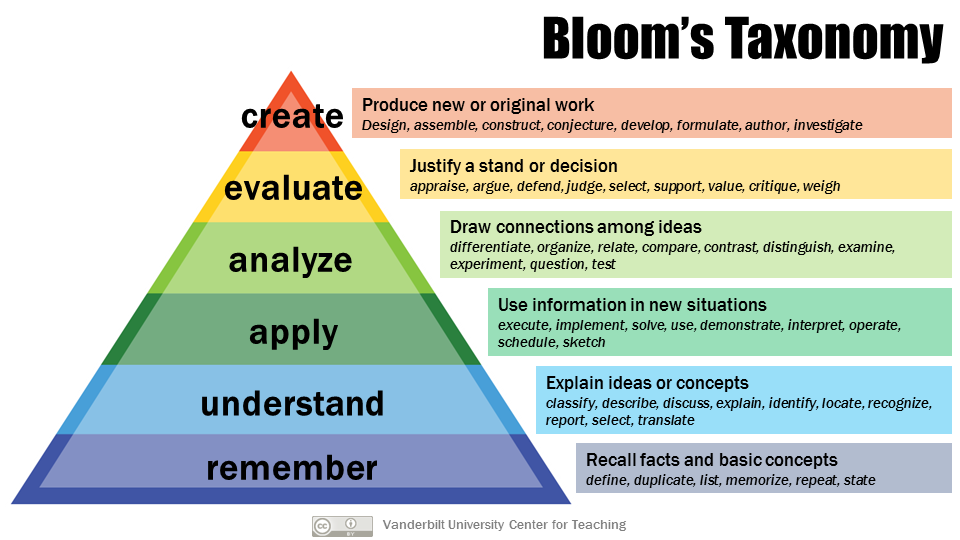
Image from: Armstrong, P. (2010). Bloom’s Taxonomy. Vanderbilt University Center for Teaching. Retrieved [04/23/2024] from https://cft.vanderbilt.edu/guides-sub-pages/blooms-taxonomy/.
Let’s move onto different levels of Bloom’s Taxonomy: –
-
Remembering (Knowledge): – “Remember” phase of Bloom’s Taxonomy is all about recalling facts or information. It’s like remembering your friend’s phone number or the capital of a country. It’s the foundation for deeper learning.
Work on building background knowledge: Ever heard of differentiated Reading Passages?
Children with neurodiverse traits benefit from reading materials that are level appropriate. With texts that are leveled across a range of difficulty, educators may scaffold comprehension. Try incorporating interesting paragraphs about subjects like science, art, or animals. Such books hold students’ attention while provide context for deductive reasoning. Clicker 8 does this by not only offering passages but exercises that scaffold comprehension. Let me take you through an example using our personal experience. Clicker book: Leveled passages.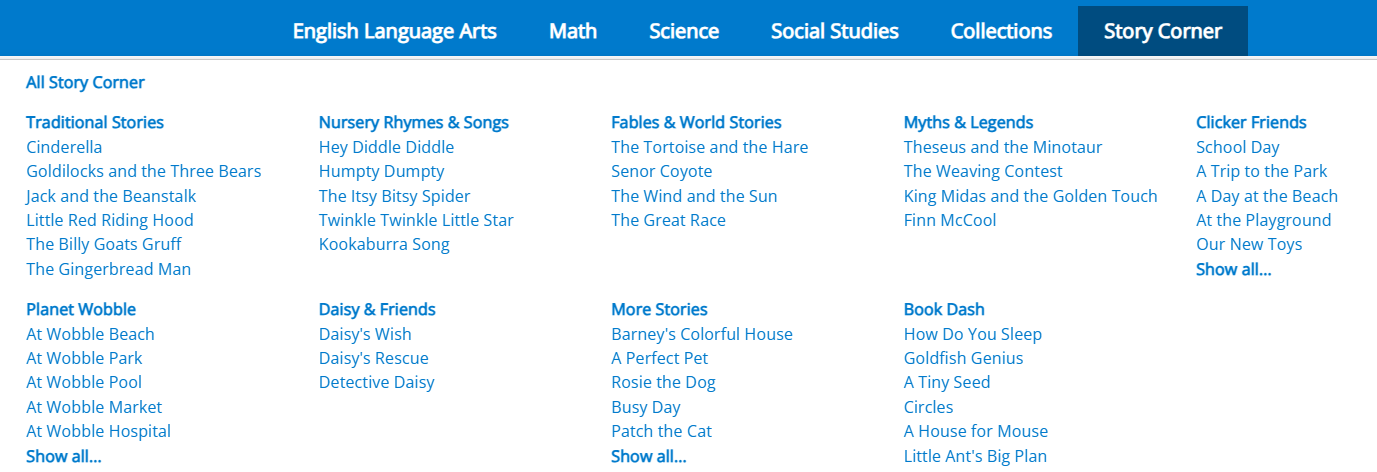
- For minimally verbal children, remembering might involve recognizing visual cues, associating images with words, or identifying familiar objects.
- At this level, children recall facts, details, and basic information. Matching Sets in Clicker do exactly this. They subtly introduce the imagery and pair it with words and/or audio. You could use the highest level of support (both visual and audio) or either.
 2. Understanding: In Bloom’s Taxonomy, the “Understanding” phase is the second level of learning. After you remember the basic facts (the “Remembering” phase), you move on to the “Understanding” phase. Here, you start to grasp the meaning of the information. It’s like going from just knowing the words of a song to actually getting what the song is about.
2. Understanding: In Bloom’s Taxonomy, the “Understanding” phase is the second level of learning. After you remember the basic facts (the “Remembering” phase), you move on to the “Understanding” phase. Here, you start to grasp the meaning of the information. It’s like going from just knowing the words of a song to actually getting what the song is about.
Clicker’s Connect Sets and Word Banks offer this scaffolded learning when a child has to put pictures and words together to make a sentence. You could start with audio and visual support and move up unscrambling sentences individually sealing the background knowledge from Clicker Books. Take a look at the options below.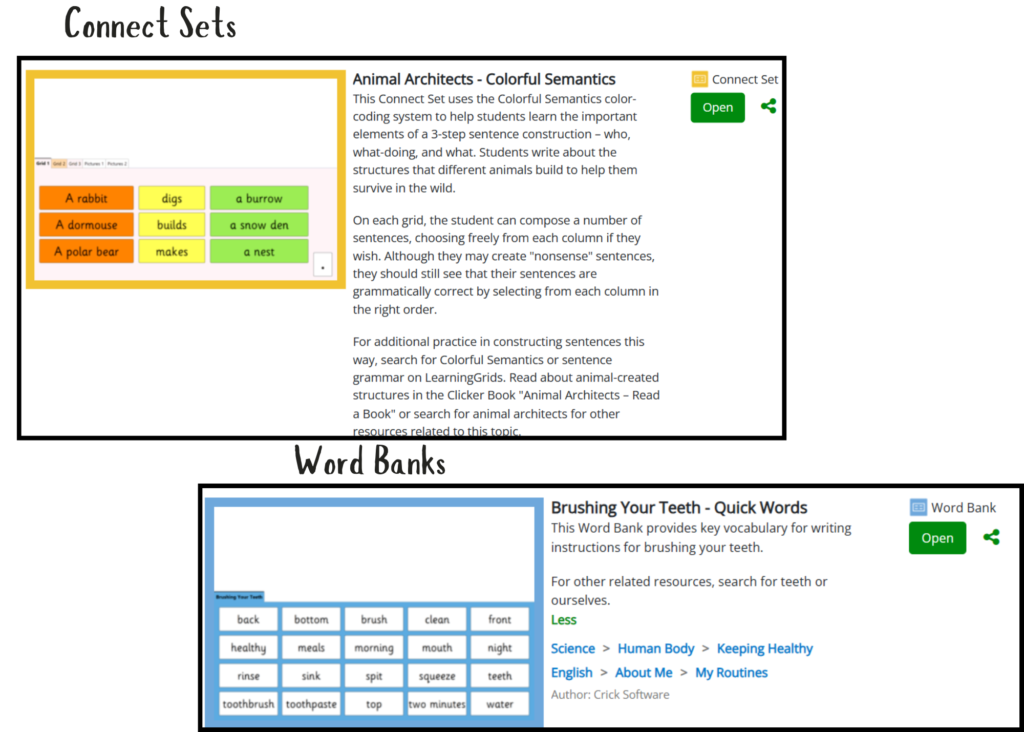 3. Applying: The “Applying” phase in Bloom’s Taxonomy is like putting what you’ve learned into action. Imagine you’ve just learned how to make a sandwich. Now, it’s time to actually make one. That’s applying!
3. Applying: The “Applying” phase in Bloom’s Taxonomy is like putting what you’ve learned into action. Imagine you’ve just learned how to make a sandwich. Now, it’s time to actually make one. That’s applying!
- Applying knowledge to real-world situations is essential.
- For minimally verbal children, this might mean using basic communication tools (such as picture cards) to express needs or preferences.
- While a student who only understands something may be able to do tasks in a classroom setting, someone who can apply that knowledge is capable of using it across different situations and contexts. In a non verbal or minimally verbal child this may look like expanding vocabulary and using it in different context. For e.g a sentence like “Let’s go to school” as read in the book gets applied as “Let’s go to park” (verbally or written). In my case my child’s utterances went up after using these Sentence Sets in Clicker 8.

4. Analyzing: The “Analyzing” phase in Bloom’s Taxonomy is like being a detective with what you’ve learned. You take apart the information to see how it all fits together. It’s the fourth level in the learning process, where you start to dig deeper.
- Breaking down complex ideas into smaller parts is crucial for deeper understanding.
- Minimally verbal children cannot analyze simple cause-and-effect relationships or patterns.
- Analyzing involves the ability to look closely at and deconstruct a concept. Usually, this involves being able to categorize it, sort it, and compare and contrast it to other concepts.
- Clicker Sets that match this level of competency: Can you remember audio and visuals to select the imagery and sequence of the story.
- Comprehending stories – WH questions: When the child is not yet there, and you are scaffolding the child’s knowledge to understand and respond, Custom Sets (Questions) such as below help immensely.


5. Evaluating: The “Evaluating” phase in Bloom’s Taxonomy is like being a judge in a talent show. You’ve learned a lot, and now you get to decide what’s good and what’s not. It’s the second-to-last level in the learning process, where you make critical judgments.
- Making judgments based on criteria is the pinnacle of cognitive development.
- While minimally verbal children may not engage in complex evaluation, they can express preferences or indicate comfort/discomfort. The following Custom Sets help you develop such higher order skills with visual support and boards.
– Describe the characters.
– Character Talk
– Clicker Board
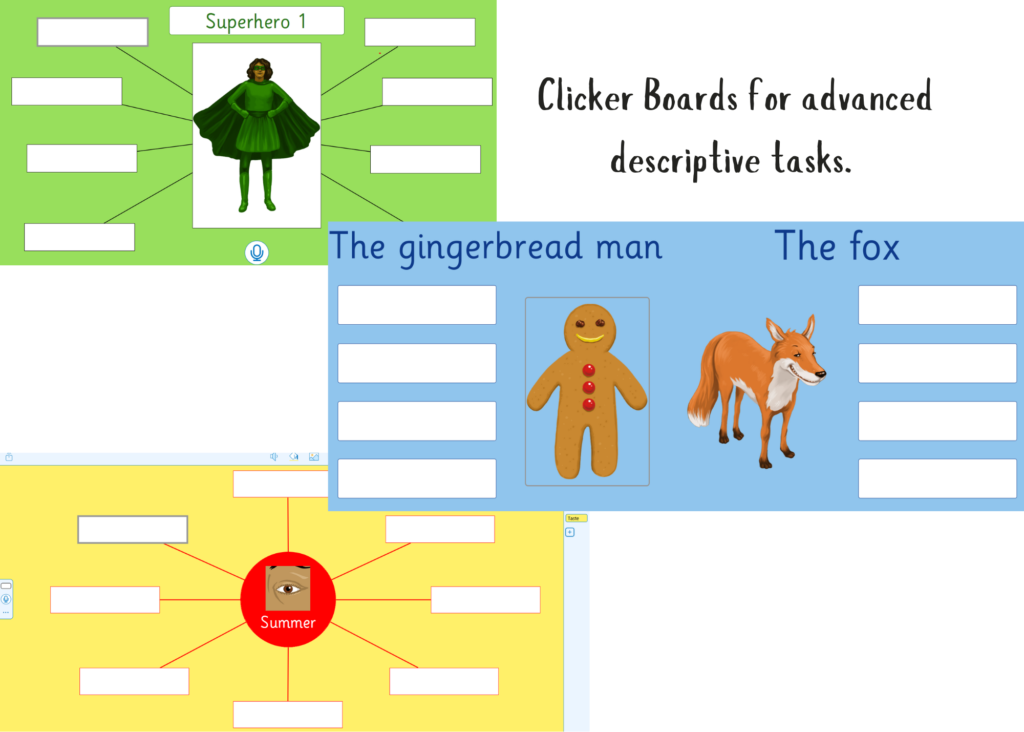
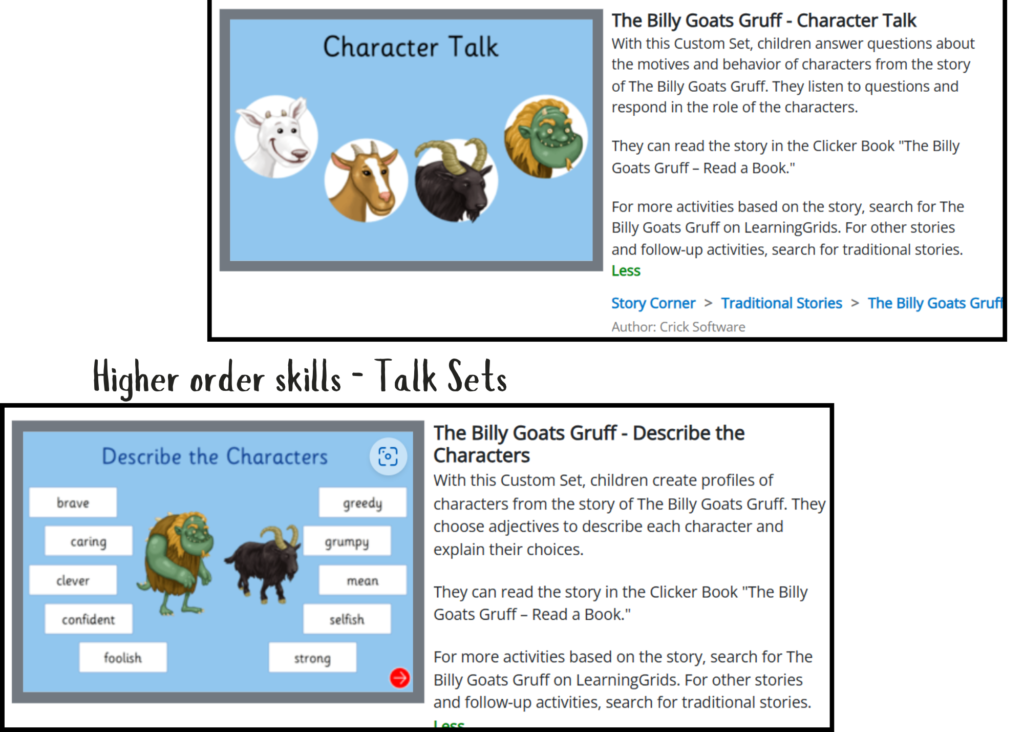
6. Creating: The “Creating” phase in Bloom’s Taxonomy is like being an inventor. It’s the top level of learning where you use everything you’ve learned to make something new or come up with original ideas. Think of it as using LEGO blocks you’ve collected to build your own unique creation. The Talk Sets and Clicker Boards encourage the child to do just that. Take it further with creative writing in Clicker using the scaffolding provided for Narrative Writing, Story planning, Story Writing etc.
In this phase, you:
-Combine different ideas to form a new whole.
-Invent a product, concept, or process that’s original.
-Design a plan or proposal for something innovative.
-Produce a work that shows your personal touch and creativity. Explore Talk Sets and Mind Maps in this phase.
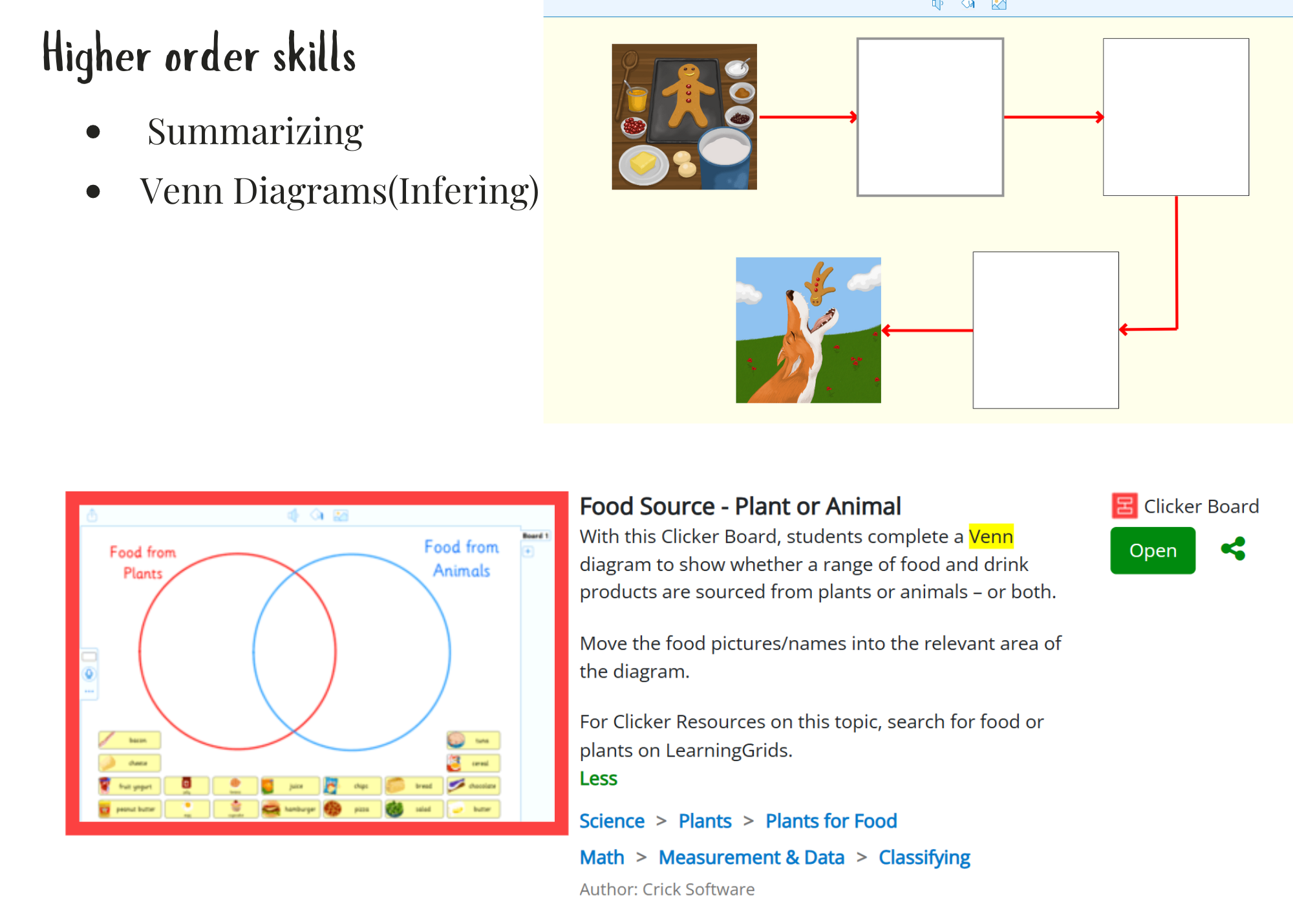
Our personal experience:
My son had no exposure typing on Clicker, about 3 years ago. Today, he can effortlessly and independently type his work. Use Sentence Sets and type them out with/without auditory support. As a gestalt learner, he can make his own sentences by combining phrases and translate what he has learnt on a unit by applying it to another unit. E.g. How to make playdoh letter one, how to draw number block 20 by generalizing structure and transition words learnt on other units. Pictures speak larger than words, well take a look at his excerpts.
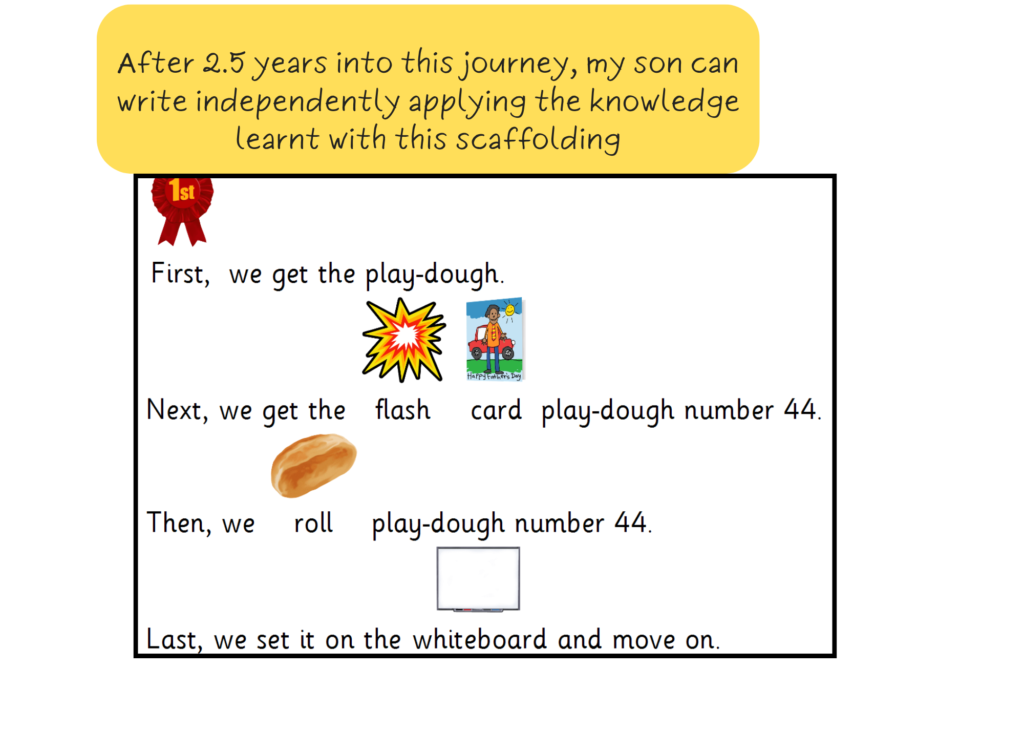 That’s not all, he has started to transcribe moments of life in his words with perfect chronology. This is COMMUNICATION and has given me pivotal insights on how he processes information, opening up more doors to support his emotional wellbeing. His utterances have gone up and he is able to convey most of his daily needs and wants in clear sentences, negotiate for alternatives!
That’s not all, he has started to transcribe moments of life in his words with perfect chronology. This is COMMUNICATION and has given me pivotal insights on how he processes information, opening up more doors to support his emotional wellbeing. His utterances have gone up and he is able to convey most of his daily needs and wants in clear sentences, negotiate for alternatives!
Conclusion:
Developing comprehension in neurodiverse children requires patience, flexibility, and a commitment to meeting each child where they are. Below infographic is a quick summary of what we have covered in this post. Hope this helps you as much as it served us.
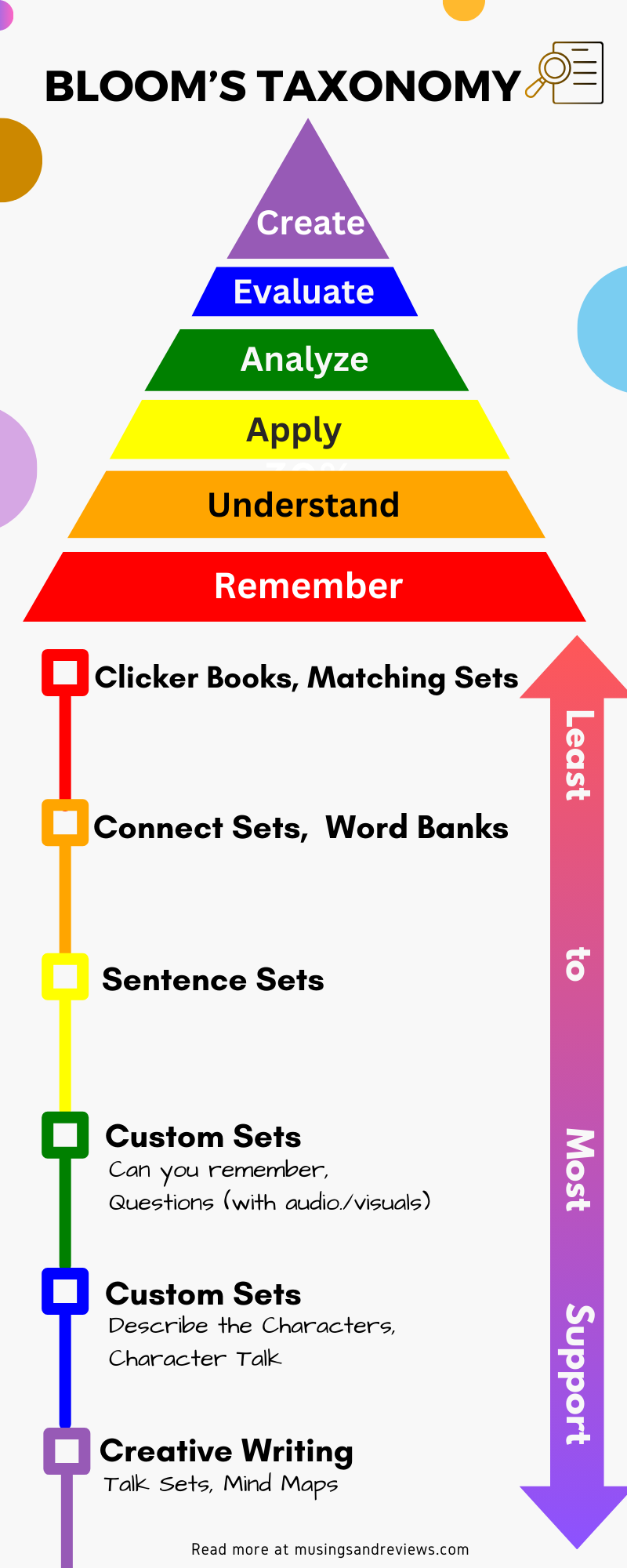
By embracing their unique perspectives and using evidence-based practices, we could empower these learners to thrive academically and beyond. I leave you with a lasting thought – let’s create an inclusive learning environment where comprehension flourishes year-round, across all phases of growth.
If you like this post, you may also find the below informative-
Teaching with Clicker 8.
Scaffolding with Clicker 8.
Vocabulary Instruction to advance Speech.
